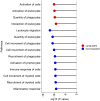Plasma proteomic profiles of pain subtypes in adolescents and young adults with endometriosis
- PMID: 37196326
- PMCID: PMC10391309
- DOI: 10.1093/humrep/dead099
Plasma proteomic profiles of pain subtypes in adolescents and young adults with endometriosis
Abstract
Study question: What are the similarities and differences in the systemic proteomic profiles by endometriosis-associated pain subtypes among adolescents and young adults with endometriosis?
Summary answer: Endometriosis-associated pain subtypes exhibited distinct plasma proteomic profiles.
What is known already: Endometriosis patients, especially those diagnosed in adolescents and young adults, are often plagued by various pain symptoms. However, it is not clear what biological processes underlie this heterogeneity.
Study design, size, duration: We conducted a cross-sectional analysis using data and plasma samples from 142 adolescent or young adult participants of the Women's Health Study: From Adolescence to Adulthood cohort with laparoscopically confirmed endometriosis.
Participants/materials, setting, methods: We measured 1305 plasma protein levels by SomaScan. We classified self-reported endometriosis-associated pain into subtypes of dysmenorrhea, acyclic pelvic pain, life impacting pelvic pain, bladder pain, bowel pain, and widespread pain phenotype. We used logistic regression to calculate the odds ratios and 95% confidence intervals for differentially expressed proteins, adjusting for age, BMI, fasting status, and hormone use at blood draw. Ingenuity Pathway Analysis identified enriched biological pathways.
Main results and the role of chance: Our study population consisted mainly of adolescents and young adults (mean age at blood draw = 18 years), with nearly all (97%) scored as rASRM stage I/II at laparoscopic diagnosis of endometriosis, which is a common clinical presentation of endometriosis diagnosed at a younger age. Pain subtypes exhibited distinct plasma proteomic profiles. Multiple cell movement pathways were downregulated in cases with severe dysmenorrhea and life impacting pelvic pain compared to those without (P < 7.5×10-15). Endometriosis cases with acyclic pelvic pain had upregulation of immune cell adhesion pathways (P < 9.0×10-9), while those with bladder pain had upregulation of immune cell migration (P < 3.7×10-8) and those with bowel pain had downregulation (P < 6.5×10-7) of the immune cell migration pathways compared to those without. Having a wide-spread pain phenotype involved downregulation of multiple immune pathways (P < 8.0×10-10).
Limitations, reasons for caution: Our study was limited by the lack of an independent validation cohort. We were also only able to explore any presence of a pain subtype and could not evaluate multiple combinations by pain subtypes. Further mechanistic studies are warranted to elucidate the differences in pathophysiology by endometriosis-pain subtype.
Wider implications of the findings: The observed variation in plasma protein profiles by pain subtypes suggests different underlying molecular mechanisms, highlighting the need for potential consideration of pain subtypes for effectively treating endometriosis patients presenting with various pain symptoms.
Study funding/competing interest(s): This study was supported by the Department of Defense W81XWH1910318 and the 2017 Boston Center for Endometriosis Trainee Award. Financial support for establishment of and data collection within the A2A cohort were provided by the J. Willard and Alice S. Marriott Foundation. N.S., A.F.V., S.A.M., and K.L.T. have received funding from the Marriott Family Foundation. C.B.S. is funded by an R35 MIRA Award from NIGMS (5R35GM142676). S.A.M. and K.L.T. are supported by NICHD R01HD094842. S.A.M. reports serving as an advisory board member for AbbVie and Roche, Field Chief Editor for Frontiers in Reproductive Health, personal fees from Abbott for roundtable participation; none of these are related to this study. Other authors report no conflict of interest.
Trial registration number: N/A.
Keywords: acyclic pelvic pain; dysmenorrhea; endometriosis; pelvic pain; plasma biomarkers; proteome; proteomics; sub-phenotypes.
© The Author(s) 2023. Published by Oxford University Press on behalf of European Society of Human Reproduction and Embryology. All rights reserved. For permissions, please email: journals.permissions@oup.com.
Conflict of interest statement
S.A.M. reports serving as an advisory board member for AbbVie and Roche, Field Chief Editor for Frontiers in Reproductive Health, personal fees from Abbott for roundtable participation; none of these are related to this study. Other authors report no conflict of interest.
Figures



Similar articles
-
Circulating proteomic profiles associated with endometriosis in adolescents and young adults.Hum Reprod. 2022 Aug 25;37(9):2042-2053. doi: 10.1093/humrep/deac146. Hum Reprod. 2022. PMID: 35770801 Free PMC article.
-
Linzagolix therapy versus a placebo in patients with endometriosis-associated pain: a prospective, randomized, double-blind, Phase 3 study (EDELWEISS 3).Hum Reprod. 2024 Jun 3;39(6):1208-1221. doi: 10.1093/humrep/deae076. Hum Reprod. 2024. PMID: 38648863 Free PMC article. Clinical Trial.
-
Two-year efficacy and safety of relugolix combination therapy in women with endometriosis-associated pain: SPIRIT open-label extension study.Hum Reprod. 2024 Mar 1;39(3):526-537. doi: 10.1093/humrep/dead263. Hum Reprod. 2024. PMID: 38243752 Free PMC article. Clinical Trial.
-
Top 10 priorities for future infertility research: an international consensus development study.Fertil Steril. 2021 Jan;115(1):180-190. doi: 10.1016/j.fertnstert.2020.11.014. Epub 2020 Nov 30. Fertil Steril. 2021. PMID: 33272617
-
Current global status of male reproductive health.Hum Reprod Open. 2024 Apr 12;2024(2):hoae017. doi: 10.1093/hropen/hoae017. eCollection 2024. Hum Reprod Open. 2024. PMID: 38699533 Free PMC article. Review.
Cited by
-
Deep Infiltrating Endometriosis in Adolescence: Early Diagnosis and Possible Prevention of Disease Progression.J Clin Med. 2024 Jan 18;13(2):550. doi: 10.3390/jcm13020550. J Clin Med. 2024. PMID: 38256683 Free PMC article. Review.
References
-
- Abbott J, Hawe J, Hunter D, Holmes M, Finn P, Garry R.. Laparoscopic excision of endometriosis: a randomized, placebo-controlled trial. Fertil Steril 2004;82:878–884. - PubMed
-
- Abbott JA, Hawe J, Clayton RD, Garry R.. The effects and effectiveness of laparoscopic excision of endometriosis: a prospective study with 2-5 year follow-up. Hum Reprod 2003;18:1922–1927. - PubMed
-
- Barlow SE; Expert Committee. Expert committee recommendations regarding the prevention, assessment, and treatment of child and adolescent overweight and obesity: summary report. Pediatrics 2007;120(Suppl 4):S164–S192. - PubMed
-
- Becker CM, Laufer MR, Stratton P, Hummelshoj L, Missmer SA, Zondervan KT, Adamson GD; WERF EPHect Working Group. World Endometriosis Research Foundation Endometriosis Phenome and Biobanking Harmonisation Project: I. Surgical phenotype data collection in endometriosis research. Fertil Steril 2014;102:1213–1222. - PMC - PubMed
Publication types
MeSH terms
Grants and funding
LinkOut - more resources
Full Text Sources
Medical
Research Materials

